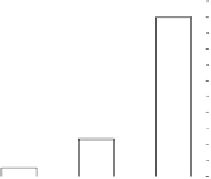Environmental Engineering Reference
In-Depth Information
25 prey per bluegill
300 prey per bluegill
1.0
1.0
0.8
0.8
0.6
0.6
0.4
0.4
0.2
0.2
0.0
0.0
1.4 2.5 3.6
1.4 2.5 3.6
5
5
4
4
3
3
2
2
1
1
0
0
1.4 2.5 3.6
1.4 2.5 3.6
Daphnia
size (mm)
Daphnia
size (mm)
FIGURE 19.6
Selectivity of bluegill
(Lepomis macrochirus)
on size of prey
(Daphnia magna)
at two prey densities. At low densities, all sizes of
Daphnia
are equally represented in the
bluegill guts. At high densities of prey, the larger zooplankton are preferred (selectivity
1
relative to expected encounter rates) (data from Werner and Hall, 1974).
A problem with using optimal foraging theory to make predictions
about behavior of predators is that an investigator may not be able to iden-
tify the most important selective forces (Gatz, 1983). For example, one
could predict that large prey is preferable to small prey. However, large
prey may be encountered infrequently and may take more energy to cap-
ture. Taking many small prey may be more energy efficient; this seems to
be the case for many predatory freshwater fishes (Juanes, 1994).
The number of prey eaten per unit prey density is referred to as the
functional response
. The number of predators per unit prey density is re-
ferred to as the
numerical response
. A functional response curve can take
one of three general forms (Fig. 19.7). In a type I functional response, pre-
dation is linearly related to prey density until some saturation is reached;
this is the simplest predation model. In a type II response, there is a hy-
perbolic response to prey density. The form of this response is similar to
that seen in the Michaelis-Menten uptake kinetics described in Chapter 16.
This form of response is typical of predators that do not have a complex
behavioral response to acquiring prey. The type III response is seen in more
advanced predators. At very low prey densities, few or no prey is taken
(optimal foraging theory predicts that there is not enough energy gain to
profitably take prey). At intermediate prey densities the rate of capture in-
creases, and eventually the predator is saturated, as in types I and II. Nu-
merical response generally occurs over longer time periods because it re-
quires changes in the predator's populations (from birth, death,
immigration, and emigration), unlike functional responses that are pri-
marily limited by behavioral and physiological aspects of the predator and
distribution of prey in the environment.

























Search WWH ::

Custom Search